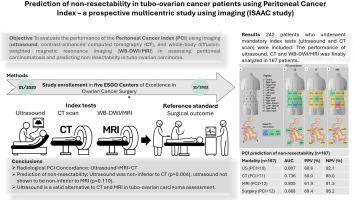Prediction of non-resectability in tubo-ovarian cancer patients using Peritoneal Cancer Index – A prospective multicentric study using imaging (ISAAC study)
IF 4.5
2区 医学
Q1 OBSTETRICS & GYNECOLOGY
引用次数: 0
Abstract
Background
The aim was to evaluate the performance of the Peritoneal Cancer Index (PCI) using imaging (ultrasound, contrast-enhanced computed tomography (CT), and whole-body diffusion-weighted magnetic resonance imaging (WB-DWI/MRI) in assessing peritoneal carcinomatosis and predicting non-resectability in tubo-ovarian carcinoma patients.
Methods
This was a prospective multicenter observational study. We considered all patients with suspected primary ovarian/tubal/peritoneal cancer who underwent preoperative ultrasound, CT, and WB-DWI/MRI (if available). The optimal cut off value for assessing the performance of the methods in predicting non-resectability was identified at the point at which the sensitivity and specificity were most similar. The reference standard to predict non-resectability was surgical outcome in terms of residual disease >1 cm or surgery not feasible. Agreement between imaging methods and surgical exploration in assessing sites included in the PCI score was evaluated using the Intraclass Correlation Coefficient (ICC).
Results
242 patients were included from January 2020 until November 2022. The optimal PCI cut-off for predicting non-resectability for surgical exploration was >12, which achieved the best AUC of 0.87, followed by ultrasound with a cut-off of >10 and AUC of 0.81, WB-DWI/MRI with a cut-off of >12 and AUC of 0.81, and CT with a cut-off of >11 and AUC of 0.74. Using ICC, ultrasound had very high agreement (0.94) with surgical PCI, while CT and WB-DWI/MRI had high agreement (0.86 and 0.87, respectively).
Conclusion
Ultrasound performed by an expert operator had the best agreement with surgical findings compared to WB-DWI/MRI and CT in assessing radiological PCI. In predicting non-resectability, ultrasound was non-inferior to CT, while its non-inferiority to WB-DWI/MRI was not demonstrated.

利用腹膜癌指数预测输卵管卵巢癌患者的不可切除性--一项利用成像技术进行的前瞻性多中心研究(ISAAC 研究)。
研究背景目的是评估腹膜癌指数(PCI)使用影像学(超声波、对比增强计算机断层扫描(CT)和全身弥散加权磁共振成像(WB-DWI/MRI))评估腹膜癌肿和预测输卵管卵巢癌患者不可切除性的性能:这是一项前瞻性多中心观察研究。我们考虑了所有疑似原发性卵巢癌/输卵管癌/腹膜癌患者,他们都接受了术前超声波、CT 和 WB-DWI/MRI(如果有的话)检查。评估各种方法预测不可切除性的性能的最佳临界值是灵敏度和特异性最接近的点。预测不可切除性的参考标准是残留病灶大于 1 厘米或手术不可行的手术结果。使用类内相关系数(ICC)评估了成像方法和手术探查在评估PCI评分所含部位方面的一致性。结果:从2020年1月到2022年11月,共纳入242例患者。预测手术探查不可切除性的最佳PCI临界值为>12,其最佳AUC为0.87;其次是超声,临界值为>10,AUC为0.81;WB-DWI/MRI,临界值为>12,AUC为0.81;CT,临界值为>11,AUC为0.74。使用ICC,超声与外科PCI的一致性非常高(0.94),而CT和WB-DWI/MRI的一致性也很高(分别为0.86和0.87):结论:在评估放射学PCI方面,与WB-DWI/MRI和CT相比,由专家操作员进行的超声与手术结果的一致性最好。在预测不可切除性方面,超声并不优于 CT,而其不优于 WB-DWI/MRI 的优势并未得到证实。
本文章由计算机程序翻译,如有差异,请以英文原文为准。
求助全文
约1分钟内获得全文
求助全文
来源期刊

Gynecologic oncology
医学-妇产科学
CiteScore
8.60
自引率
6.40%
发文量
1062
审稿时长
37 days
期刊介绍:
Gynecologic Oncology, an international journal, is devoted to the publication of clinical and investigative articles that concern tumors of the female reproductive tract. Investigations relating to the etiology, diagnosis, and treatment of female cancers, as well as research from any of the disciplines related to this field of interest, are published.
Research Areas Include:
• Cell and molecular biology
• Chemotherapy
• Cytology
• Endocrinology
• Epidemiology
• Genetics
• Gynecologic surgery
• Immunology
• Pathology
• Radiotherapy
 求助内容:
求助内容: 应助结果提醒方式:
应助结果提醒方式:


